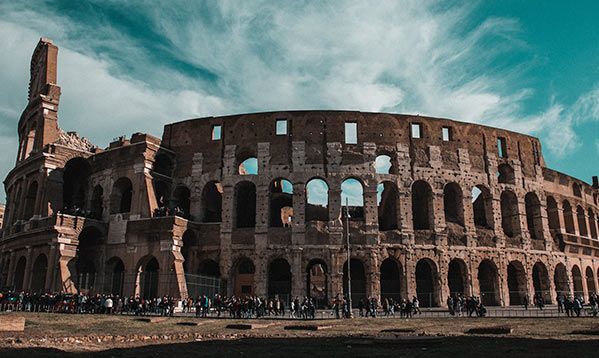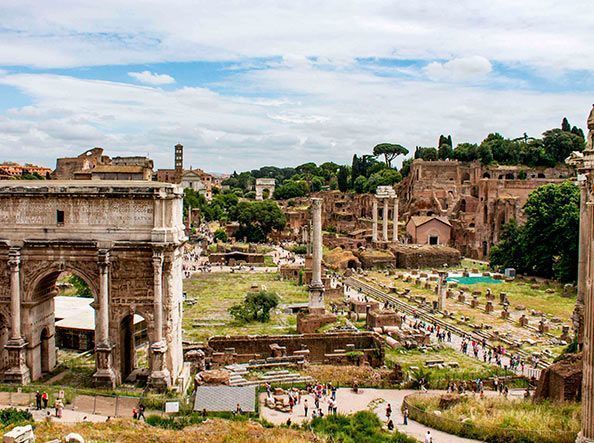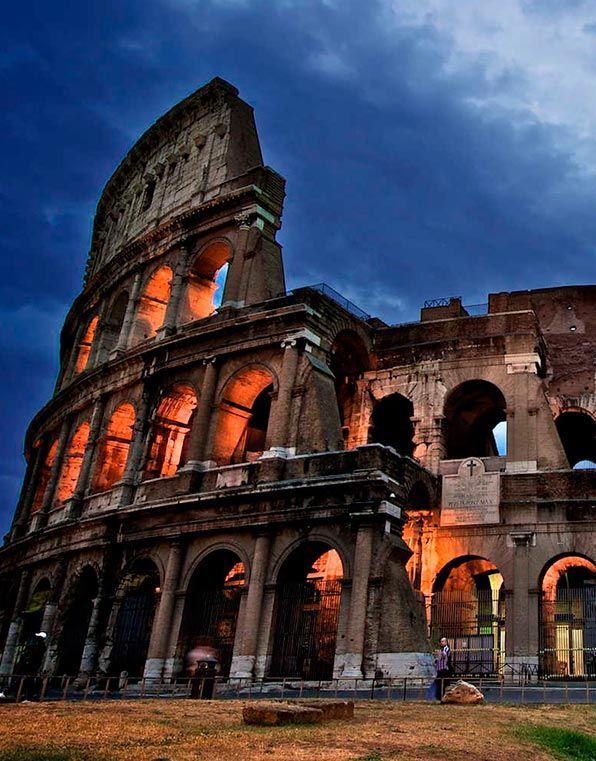Colosseum Information
Colosseum CONTEXT
The Colosseum is an oval amphitheatre found in the heart of Rome, Italy. It’s a freestanding structure made of stone and concrete, unlike its predecessors that were built into hillsides to provide adequate support. It’s three stories of arched entrances and supported by semi-circular columns. Each story has columns of different styles.
Visit The Colosseum

Travel back to ancient Rome by visiting the Colosseum, an iconic man-made monument that consists of an oval amphitheatre, the Romans main entertainment center commissioned by the emperor Vespasian, and completed under his successor and heir, Titus. To help them forget their daily struggles and satisfy their primal needs to witness fights until the death, animal hunts and other spectacles.

Visit The Colosseum
Travel back to ancient Rome by visiting the Colosseum, an iconic man-made monument that consists of an oval amphitheatre, the Romans main entertainment center commissioned by the emperor Vespasian, and completed under his successor and heir, Titus. To help them forget their daily struggles and satisfy their primal needs to witness fights until the death, animal hunts and other spectacles.
History of the Colosseum

During its golden age it could receive between 50,000 and 80,000 spectators, and it was the largest amphitheatre built at the time in 80 AD, but construction began 8 years prior in 72 AD. The main purpose of the Colosseum was to entertain the people of Rome with different spectacles like contests between gladiators, mock sea battles, animal hunts, executions, famous battles reenactments, and dramas from Classical mythology. These shows were witnessed up until the medieval era. Later on the Colosseum would be used for housing, workshops, and other uses as well.
History of the Colosseum
During its golden age it could receive between 50,000 and 80,000 spectators, and it was the largest amphitheatre built at the time in 80 AD, but construction began 8 years prior in 72 AD. The main purpose of the Colosseum was to entertain the people of Rome with different spectacles like contests between gladiators, mock sea battles, animal hunts, executions, famous battles reenactments, and dramas from Classical mythology. These shows were witnessed up until the medieval era. Later on the Colosseum would be used for housing, workshops, and other uses as well.



Parts of Colosseum



The main feature of the Colosseum is its arena, the space were the action took place. Battles between gladiators, animal executions, dramatic plays and battle reenactments were witnessed there.
Then the hypogeum was created, built 10 years later the inauguration, which is the substructure of the Colosseum that allowed the arena to have naval battles.



Parts of Colosseum
The main feature of the Colosseum is its arena, the space were the action took place. Battles between gladiators, animal executions, dramatic plays and battle reenactments were witnessed there.
Then the hypogeum was created, built 10 years later the inauguration, which is the substructure of the Colosseum that allowed the arena to have naval battles.
Arch of Constantine



The Arch of Constantine stands between the Colosseum and the Palatine Hill. It was commissioned by the Roman Senate to commemorate Roman Emperor Constantine’s victory over the Roman tyrant Maxentius at the battle of Milvian Bridge in Rome. It’s the only Roman triumphal arch that still stands today and the last great monument of Imperial Rome, .The arch is also a statement of political propaganda, stating that Constantine was one of the most successful Roman emperors, known best for their many military victories and good government. The location spanned the ancient route for Roman triumphs at its origin, where it diverged from the VIa sacra. This route was taken by the emperors when they marched into the city after a military victory.
Arch of Constantine
The Arch of Constantine stands between the Colosseum and the Palatine Hill. It was commissioned by the Roman Senate to commemorate Roman Emperor Constantine’s victory over the Roman tyrant Maxentius at the battle of Milvian Bridge in Rome. It’s the only Roman triumphal arch that still stands today and the last great monument of Imperial Rome, .The arch is also a statement of political propaganda, stating that Constantine was one of the most successful Roman emperors, known best for their many military victories and good government. The location spanned the ancient route for Roman triumphs at its origin, where it diverged from the VIa sacra. This route was taken by the emperors when they marched into the city after a military victory.



Roman Forum



The Roman Forum is located east of the Colosseum. It was ancient Rome’s main plaza in the center of the city, and surrounded by government buildings. This was Rome’s most busy place – aside from the Colosseum – that was filled everyday with people on their day to day commercial affairs, also the spot for elections, public speeches and triumphal processions (civic and military processions to celebrate victories and religious rites) were celebrated. It was also a very popular venue to see gladiatorial battles up-close, front and center.



Roman Forum
The Roman Forum is located east of the Colosseum. It was ancient Rome’s main plaza in the center of the city, and surrounded by government buildings. This was Rome’s most busy place – aside from the Colosseum – that was filled everyday with people on their day to day commercial affairs, also the spot for elections, public speeches and triumphal processions (civic and military processions to celebrate victories and religious rites) were celebrated. It was also a very popular venue to see gladiatorial battles up-close, front and center.
Palatino Hill



The entrance is midway down the road Via di San Gregorio that runs from the Colosseum along the base of Palatine Hill, and takes about a 5 minute walk downhill to the Colosseum. The Palatine Hill stands 40 metres above the Roman Forum. It’s the centremost of the seven hills of Rome and is considered the “first nucleus of the Roman Empire”. Because it was mainly a residential hill were the rich and wealthy lived in their fancy houses and palaces. What stands today are mostly ruins of what used to be Rome’s suburbs. We recommend to tour the Palatine hill with an expert guide to really get a grasp on what it represented for Rome then and how it helped shape the world’s future in politics and economy as well.
Palatino Hill
The entrance is midway down the road Via di San Gregorio that runs from the Colosseum along the base of Palatine Hill, and takes about a 5 minute walk downhill to the Colosseum. The Palatine Hill stands 40 metres above the Roman Forum. It’s the centremost of the seven hills of Rome and is considered the “first nucleus of the Roman Empire”. Because it was mainly a residential hill were the rich and wealthy lived in their fancy houses and palaces. What stands today are mostly ruins of what used to be Rome’s suburbs. We recommend to tour the Palatine hill with an expert guide to really get a grasp on what it represented for Rome then and how it helped shape the world’s future in politics and economy as well.



Colosseum at night
Now, there is a special tour available for tourists to visit the Colosseum at night which gives you a different perspective on this monument. It will allow you to walk through the corridors -completely empty!- and get a chance to truly admire the architecture and ingenuity that took to build the Colosseum.



Tips and Facts about Colosseum
The Colosseum is one of ancient Rome’s must see attractions. It’s an oval amphitheatre that welcomed between 50,000 and 80,000 Roman spectators for several centuries. Battles between gladiators, animal executions, dramatic plays, and even naval battles (thanks to the hypogeum installed 10 years later) were the Colosseum’s main events entertained the masses. Did you know that over 9,000 animals and 2,000 people were killed during 100 days of conquests to mark the Colosseum’s inauguration in 80 AD.
To visit the Colosseum during the day is to walk through the stands, get a grasp of how magnificent this monument really is, and you also get to tour alongside 3,000 more Since it’s a much more private experience and tickets are limited, you get to enjoy the beauty and silence of the place. During this unique tour you will be able to visit the first and second floor – also available during the day – but this one will also grant you entrance to the arena and to the hypogeum as well. You get the chance to stand where gladiators fought for their lives, and get to see and understand how the arena filled with water to entertain with naval battles. All of this is alongside an expert guide and tickets usually sell quickly. Book in advance if you wish to know the Colosseum at night.



Tips and Facts about Colosseum
The Colosseum is one of ancient Rome’s must see attractions. It’s an oval amphitheatre that welcomed between 50,000 and 80,000 Roman spectators for several centuries. Battles between gladiators, animal executions, dramatic plays, and even naval battles (thanks to the hypogeum installed 10 years later) were the Colosseum’s main events entertained the masses. Did you know that over 9,000 animals and 2,000 people were killed during 100 days of conquests to mark the Colosseum’s inauguration in 80 AD.
To visit the Colosseum during the day is to walk through the stands, get a grasp of how magnificent this monument really is, and you also get to tour alongside 3,000 more Since it’s a much more private experience and tickets are limited, you get to enjoy the beauty and silence of the place. During this unique tour you will be able to visit the first and second floor – also available during the day – but this one will also grant you entrance to the arena and to the hypogeum as well. You get the chance to stand where gladiators fought for their lives, and get to see and understand how the arena filled with water to entertain with naval battles. All of this is alongside an expert guide and tickets usually sell quickly. Book in advance if you wish to know the Colosseum at night.